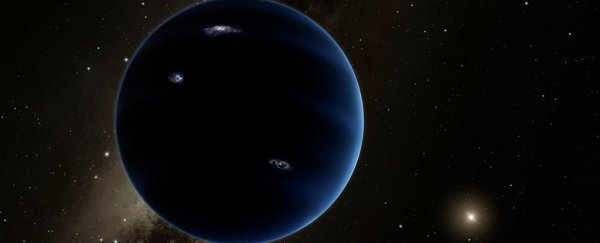Everything about Planet Nine is weird. There's the fact that something 10 times more massive than Earth and four times its size might have been lurking on the outer edges of our Solar System this whole time, and we've only just noticed it.
And what about its super-elongated orbit, which appears to take an incredible 10,000 to 20,000 years to complete? But forget all that, we don't even really know if it even exists yet!
The good news is scientists are finally narrowing in on this shady character, and a new study suggests something pretty extraordinary - Planet Nine is actually an exoplanet from a neighbouring planetary system that our Sun stole from another star. Wha??
"It is almost ironic that while astronomers often find exoplanets hundreds of light years away in other solar systems, there's probably one hiding in our own backyard," says one of the team, astronomer Alexander Mustill from Lund University in Sweden.
We all heard about Planet Nine back in January, when Mike "Pluto Killer" Brown, an astronomer from the California Institute of Technology (Caltech), announced that he and his colleagues had found evidence of something enormous on the outer edges of the Solar System.
We're talking 149 billion or so kilometres away from the Sun here, or something 75 times more distant than Pluto.
The evidence is based on the strange alignment of rocky objects in the Kuiper belt, called Kuiper Belt Objects (KBOs), way out there, which seems to suggest that some kind of massive cosmic body is exerting a very strong gravitational force on them.
"We saw a strange signal in the data that meant something odd was going on in the outer Solar System," Brown told Ian Sample at The Guardian. "All of these distant objects were lined up in a weird way and that shouldn't happen. We worked through the mundane explanations, but none of them worked out."
Since then, we've had the vague possibility of that massive cosmic body being a secret planet, but because it's so far away from us, scientists are still trying to figure out how to get some kind of spacecraft out there to take a look.
But Mustill and his team have been investigating the possibilities from the comfort of their own lab, because something just didn't add up about the prospect of a giant planet orbiting the Sun so far out.
"What we were wondering is, how could you actually form a planet out there? Because the rest of the Solar System appears to be so compact, and then you have this enormous gap where there's really not very much, and then a very large planet, nearly 10 times the mass of Earth," he says in the video below. "It seems a little implausible to us that you would just 'create' this thing out at such a distance."
Instead, the team suggested that Planet Nine was actually formed around another star - not our Sun - and it was 'captured' by our own Solar System during a close encounter some 4.5 billion years ago, just like it might have stolen mini planet Sedna away too.
With that hypothesis in mind, Mustill and his team ran the scenario through a number of computer simulations of encounters between our Solar System and another planetary system, and found that for systems with a wide-orbit planet, the likelihood that it would be captured by our Sun was about 50 percent.
But, as Shannon Hall reports for New Scientist, we can't get too excited about those odds just yet:
"Those are pretty good odds, but they dropped when the team took into account whether the passing planetary system would have a wide-orbit planet in the first place. Also, it wasn't enough to just capture a planet - their simulations only worked if they captured one that was exactly like Planet Nine. Overall, Mustill and his colleagues think the chance that Planet Nine is an exoplanet ranges from 0.1 to 2 percent."
Damn. But don't be disappointed, because it's not as bad as it sounds. "Although these probabilities seem low, you have to compare them to each other, and not absolutely," Mustill told Hall. "Because ultimately, any very specific outcome is very unlikely."
He added that the probability of Planet Nine being an exoplanet is up to 300 times higher than its existence in the Solar System being down to random chance, so it's all about persective, really.
"Planet 9 may very well have been 'shoved' by other planets, and when it ended up in an orbit that was too wide around its own star, our Sun may have taken the opportunity to steal and capture Planet 9 from its original star," he says. "When the Sun later departed from the stellar cluster in which it was born, Planet 9 was stuck in an orbit around the Sun."
Of course, this is all just informed speculation, and nothing has been physically confirmed yet, so we have to keep a cool head about this for now, until we can get a probe all the way out there and possibly snap some images. But if it ends up being a planet from another system, that's going to be incredible.
"This is the only exoplanet that we, realistically, would be able to reach using a space probe," says Mustill.
The study has been published in Monthly Notices of the Royal Astronomical Society: Letters, and you can find out more in the video below:

